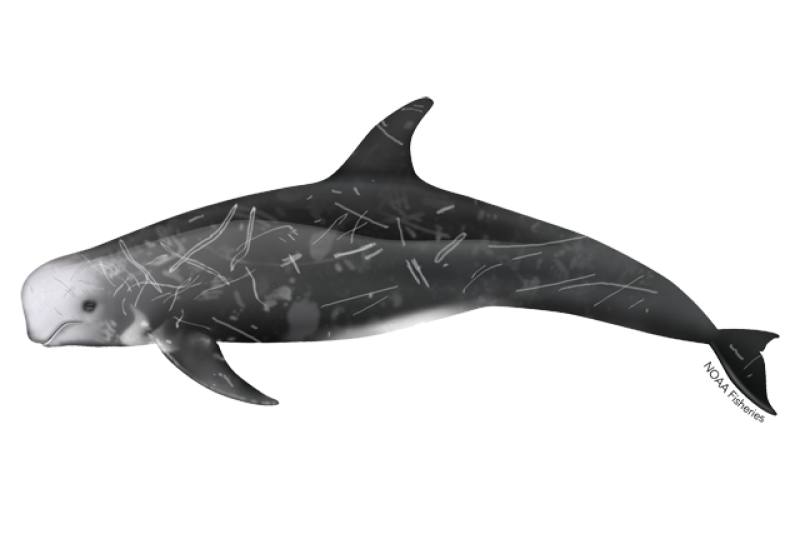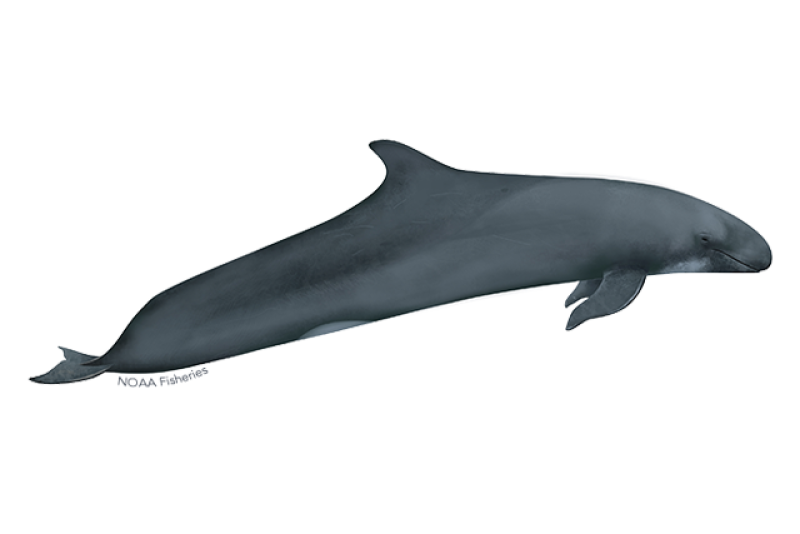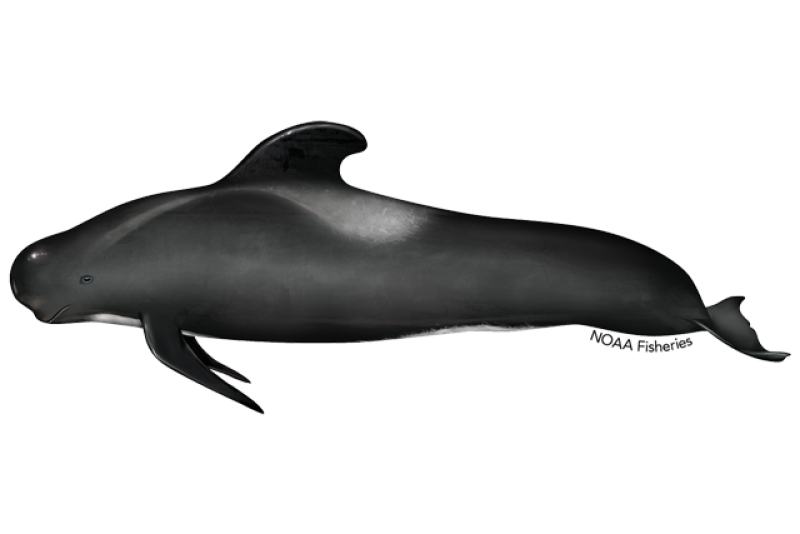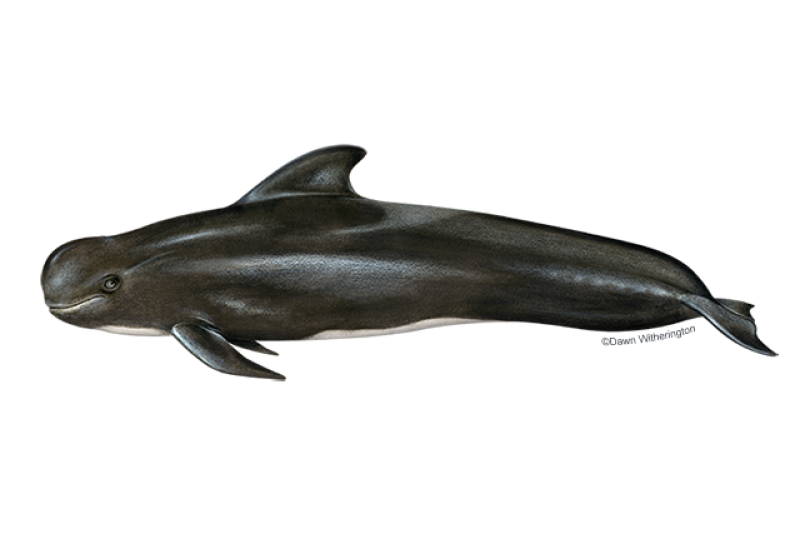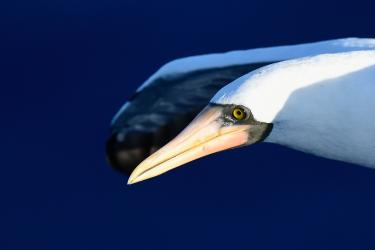Rough-Toothed Dolphin
Steno bredanensis

Protected Status
Quick Facts
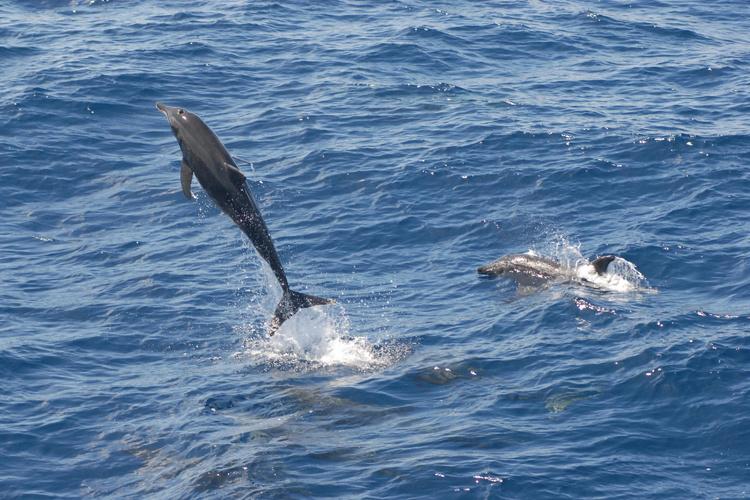 Rough-toothed dolphin. Credit: NOAA Fisheries
Rough-toothed dolphin. Credit: NOAA Fisheries
Rough-toothed dolphin. Credit: NOAA Fisheries
About the Species
 Rough-toothed dolphin. Credit: NOAA Fisheries
Rough-toothed dolphin. Credit: NOAA Fisheries
Rough-toothed dolphin. Credit: NOAA Fisheries
Rough-toothed dolphins are found throughout the world in tropical and warmer temperate waters. These small members of the dolphin family usually travel in small, tight-knit groups of two to 20 individuals. Their common name was based on the ridges found on their teeth, which are unique to this species.
Rough-toothed dolphins can remain underwater for up to 15 minutes. They can also adapt well to captivity, which is unusual for oceanic dolphins.
Rough-toothed dolphins, like all marine mammals, are protected under the Marine Mammal Protection Act (MMPA). NOAA Fisheries and its partners are working to conserve rough-toothed dolphins and further our understanding of this species through research and conservation activities.
Population Status
NOAA Fisheries estimates population size in its stock assessment reports.
The worldwide population of rough-toothed dolphins is unknown. To manage rough-toothed dolphins in U.S. waters, we have divided them into four stocks:
- American Samoa
- Hawaiian stock
- Gulf of America* (formerly Gulf of Mexico) stock
- Western North Atlantic stock
Our scientists estimate that there are about 6,000 dolphins in the Hawaiian stock, 600 dolphins in the northern Gulf of America stock, and 300 dolphins in the western North Atlantic stock—for a total of about 6,900 rough-toothed dolphins in U.S. waters.
Appearance
Rough-toothed dolphins are relatively small compared to other dolphins. They can reach up to 8.5 feet in length and weigh about 350 pounds. They have a small head with a long rostrum and no demarcation between their gently sloping melon (or forehead) and rostrum. Their dorsal fin and pectoral fins or flippers are distinctively large, which is characteristic of this species. They have a “reptilian” appearance that is also distinct and unique among dolphins.
Rough-toothed dolphins have dark gray bodies with a white throat and “lips.” They also have a narrow dark cape that runs down their back between the blowhole and dorsal fin. Their underside usually has some white or lighter spots or blotches.
Behavior and Diet
Rough-toothed dolphins are usually found in tight-knit groups of approximately 10 to 20 individuals. However in Hawaii, they are found in smaller groups of on average three individuals and a median group size of seven; they are rarely observed in larger groups of up to 100 individuals. They often associate with other cetacean species, including short-finned pilot whales, bottlenose dolphins, pantropical spotted dolphins, and spinner dolphins. They eat squid and a variety of fish.
Where They Live
Rough-toothed dolphins are found in deep oceanic waters throughout tropical and warmer temperate areas of the world. They are generally found in the Atlantic, Indian, and Pacific Oceans from 40° North to 35° South. The main factor in determining their preferred habitat is the abundance of prey.
Lifespan & Reproduction
Rough-toothed dolphins can live for up to 36 or more years. Sexual maturity occurs at 10 to 14 years of age. Little else is known about their reproductive behavior.
Threats
Entanglement
One of the main threats to rough-toothed dolphins is entanglement in commercial fishing gear, such as long line fisheries in Hawaii and American Samoa, which can injure or kill them.
Hunting
Rough-toothed dolphins have been killed in direct fisheries in Japan, Sri Lanka, Indonesia, Papua New Guinea, the Solomon Islands, West Africa, and the Caribbean Sea.
Ocean Noise
Underwater noise pollution interrupts the normal behavior of rough-toothed dolphins, which rely on sound to communicate and echolocate. If loud enough, noise can cause temporary or permanent hearing loss. Noise interference from vessels, as well as industrial and military activities, disturbs rough-toothed dolphins’ feeding, communication, and orientation, and other behaviors.
*Executive Order 14172, “Restoring Names That Honor American Greatness” (Jan. 20, 2025), directs that the Gulf of Mexico be renamed the Gulf of America. Gulf of America references in this website refer to the same area as the Gulf of Mexico in the applicable regulations under 50 CFR parts 216–219, 222–226, and 600–699. The name change did not result in any changes to, and had no effect on the applicability or enforceability of, any existing regulations. This website continues to use “Gulf of Mexico” when quoting statutes, existing regulations, or previously published materials.
Scientific Classification
| Kingdom | Animalia | Phylum | Chordata | Class | Mammalia | Order | Cetacea | Family | Delphinidae | Genus | Steno | Species | bredanensis |
|---|
Last updated by NOAA Fisheries on 04/24/2025
What We Do
Conservation & Management
NOAA Fisheries is committed to the protection of rough-toothed dolphins. Targeted management actions taken to secure protections for these dolphins include:
- Overseeing marine mammal health and stranding response
- Addressing ocean noise
- Educating the public about rough-toothed dolphins and the threats they face
Science
Our research projects have discovered new aspects of rough-toothed dolphin biology, behavior, and ecology and helped us better understand the challenges that all rough-toothed dolphins face. Our work includes:
- Stock assessments
- Monitoring population abundance and distribution
How You Can Help
Keep Your Distance
Be responsible when viewing marine life in the wild. Observe all dolphins and porpoises from a safe distance of at least 50 yards and limit your time spent observing to 30 minutes or less.
Report Marine Life in Distress
Report a sick, injured, entangled, stranded, or dead animal to make sure professional responders and scientists know about it and can take appropriate action. Numerous organizations around the country are trained and ready to respond. Never approach or try to save an injured or entangled animal yourself—it can be dangerous to both the animal and you.
Learn who you should contact when you encounter a stranded or injured marine animal
Report a Violation
Call the NOAA Fisheries Enforcement Hotline at (800) 853-1964 to report a federal marine resource violation. This hotline is available 24 hours a day, 7 days a week for anyone in the United States.
You may also contact your closest NOAA Office of Law Enforcement field office during regular business hours.
Do Not Interact with Marine Animals in the Wild
Do not harass, feed, hunt, capture, kill, pursue, approach, surround, swim with, or attempt to touch protected marine wildlife. Never entice protected marine wildlife to approach you.
Do not engage, chase, or try to get a reaction from the animal. Disturbing wildlife interrupts their ability to perform critical functions such as feeding, breeding, nursing, resting, and socializing.
If you’re on a vessel and a marine animal approaches you, put the engine in neutral and allow the animal to continue on its way.
Featured News
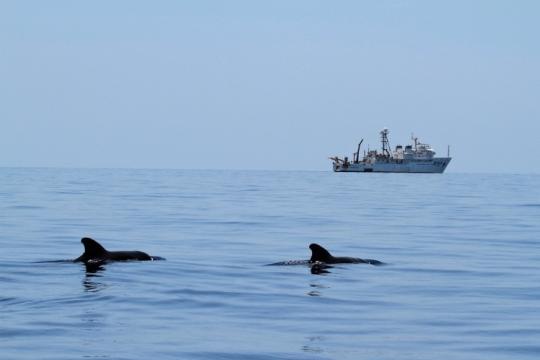 Pilot whales surface near the NOAA Ship Gordon Gunter. Credit: NOAA Fisheries/Melody Baran (Permit # 14450)
Pilot whales surface near the NOAA Ship Gordon Gunter. Credit: NOAA Fisheries/Melody Baran (Permit # 14450)
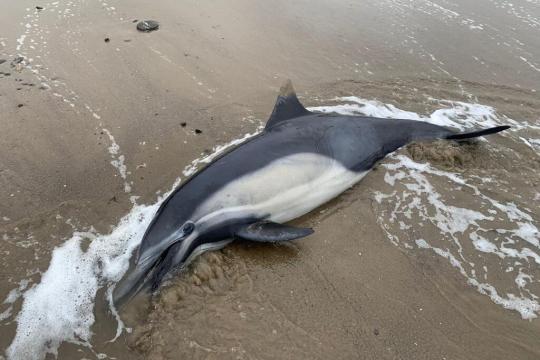 Deceased dolphin as a result of domoic acid poisoning. Credit: Channel Islands Marine & Wildlife Institute
Deceased dolphin as a result of domoic acid poisoning. Credit: Channel Islands Marine & Wildlife Institute
Toxic Algal Bloom Suspected in Dolphin and Sea Lion Deaths in Southern California
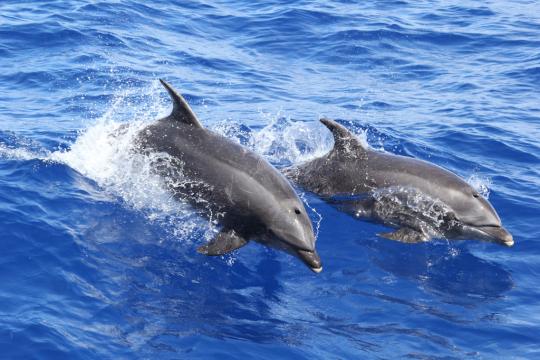 Pair of bottlenose dolphins. Credit: NOAA Pacific Islands Fisheries Science Center/Lisa Morse.
Pair of bottlenose dolphins. Credit: NOAA Pacific Islands Fisheries Science Center/Lisa Morse.
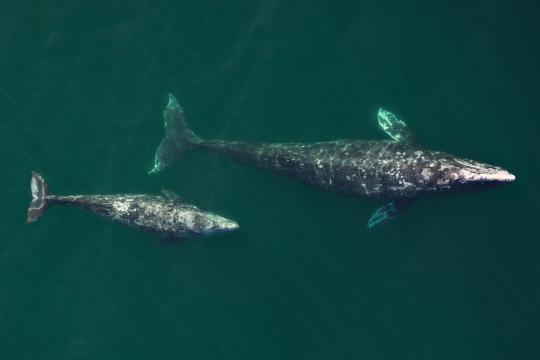 Gray whales were nearly hunted to extinction by commercial whaling. Protections under the MMPA, ESA, and the end of commercial whaling have allowed the species to recover. Credit: NOAA Fisheries (Permit #19091).
Gray whales were nearly hunted to extinction by commercial whaling. Protections under the MMPA, ESA, and the end of commercial whaling have allowed the species to recover. Credit: NOAA Fisheries (Permit #19091).
Celebrating 50 Years of the Marine Mammal Protection Act
Management Overview
The rough-toothed dolphin is protected throughout its range under the Marine Mammal Protection Act.
Additionally, the rough-toothed dolphin is listed under:
- Appendix II of the Convention on International Trade in Endangered Species of Wild Fauna and Flora (CITES)
- Annex II of the Protocol for Specially Protected Areas and Wildlife (SPAW)

Conservation Efforts
Overseeing Marine Mammal Health and Stranding Response
We work with volunteer networks in all coastal states to respond to marine mammal strandings including all dolphins and porpoises. When stranded animals are found alive, NOAA Fisheries and our partners assess the animal’s health and determine the best course of action. When stranded animals are found dead, our scientists work to understand and investigate the cause of death. Although the cause often remains unknown, scientists can sometimes attribute strandings to disease, harmful algal blooms, vessel strikes, fishing gear entanglements, pollution exposure, and underwater noise. Some strandings can serve as indicators of ocean health, giving insight into larger environmental issues that may also have implications for human health and welfare.
Learn more about the Marine Mammal Health and Stranding Response Program
Marine Mammal Unusual Mortality Events
Rough-toothed dolphins have been part of a declared unusual mortality event in the past. Under the Marine Mammal Protection Act, an unusual mortality event is defined as "a stranding that is unexpected; involves a significant die-off of any marine mammal population; and demands immediate response." To understand the health of marine mammal populations, scientists study unusual mortality events.
Get information on active and past UMEs
Get an overview of marine mammal UMEs
Addressing Ocean Noise
Underwater noise threatens rough-toothed dolphin populations, interrupting their normal behavior and driving them away from areas important to their survival. Increasing evidence suggests that exposure to intense underwater sound in some settings may cause some rough-toothed dolphins to strand and ultimately die. NOAA Fisheries is investigating all aspects of acoustic communication and hearing in marine animals, as well as the effects of sound on whale behavior and hearing. In 2016, we issued marine mammal acoustic technical guidance for assessing the effects of anthropogenic (human-caused) sound on marine mammals’ hearing.
Educating the Public
NOAA Fisheries aims to increase public awareness and support for rough-toothed dolphin conservation through education, outreach, and public participation. We share information with the public about the status of rough-toothed dolphins, as well as our research and efforts to promote their recovery.
Regulatory History
All marine mammals, including rough-toothed dolphins, are protected in the United States under the Marine Mammal Protection Act.
Key Actions and Documents
Last updated by NOAA Fisheries on 04/24/2025
Science Overview
NOAA Fisheries conducts various research activities on the biology, behavior, and ecology of rough-toothed dolphins. The results of this research are used to inform management decisions for this species.

Stock Assessments
Determining the size of rough-toothed dolphin populations helps resource managers determine the success of conservation measures. Our scientists collect population information and present the data in annual stock assessment reports.
Monitoring Population Abundance and Distribution
Scientists observe rough-toothed dolphins to record their numbers and distribution. By comparing numbers collected over multiple years, scientists can look for trends—i.e., whether the population is increasing, decreasing, or remaining stable during a given period.
More Information
Recent Science Blogs
Last updated by NOAA Fisheries on 04/24/2025
Outreach & Education
Dolphin Friendly Fishing Tips Sign
This sign is often posted near boat ramps, piers, docks, marinas, and waterfront parks.
Protect Wild Dolphins Sign
This sign is often posted near boat ramps, piers, docks, marinas, and waterfront parks.
Don't Feed Wild Dolphin Sign
This sign is often posted near boat ramps, piers, docks, marinas, and waterfront parks.
Last updated by NOAA Fisheries on 04/24/2025
